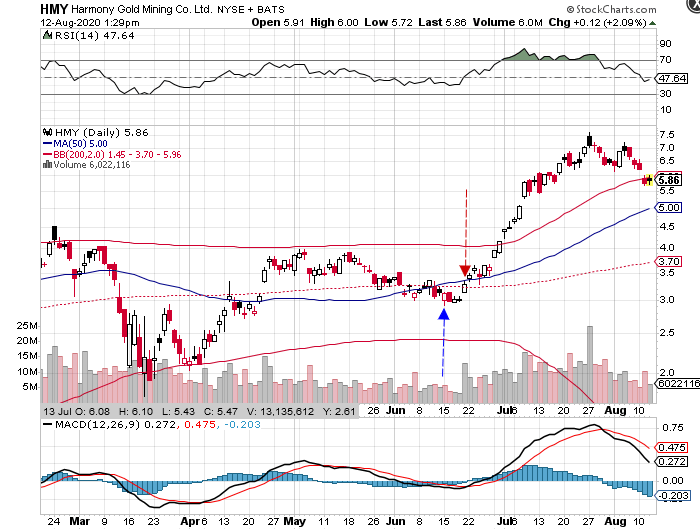Example of a swing low…
The low of the candle marked by the blue arrow is not broken below by any subsequent candles. That is the first requirement for a swing low.
However, that candle did not officially become a “swing low” until 4 days later when the high of the candle marked by the blue arrow was finally surpassed by the candle marked by the red arrow (the candle put in the day after the candle marked by the blue arrow came up a couple of pennies shy of making a higher high).
There are probably dozens of swing lows (and swing highs) on this chart, however a swing low that is in the “timing band” can mark a cycle low under cycle theory (daily cycle, weekly or “intermediate cycle,” and yearly cycle depending on the time frame looked at). In this case, the candle marked with the blue arrow constituted “a daily cycle low” for HMY. Cycle lengths vary by security/commodity (they are measured trough to trough) and you would have to ask a cyclist how long a cycle for a particular security is. For the same security or commodity, you could get two different answers about cycle length from two cyclists, although I think most would agree that weekly or “intermediate” cycles in gold are roughly 25 to 30 weeks long.

Thanks! Keep us in the loop with swing lows you see in gold, silver & GDX
Man.. I might just start doing cycle analysis now…
It’s definitely not perfect, and they do have a fudge factor where cycles can “stretch” or run short.
However, $gold’s intermediate cycles are probably the easiest and most consistent to follow of anything. Cycles represent nothing more than normal profit taking in a bull market.
One useful thing about cycles is it lets you objectively define bull and bear markets beyond just looking for higher highs and higher lows over arbitrary timeframes. In a true trending bull market, an ICL should never drop below the previous ICL IMO. While that fact may not spare you if you buy at the top of a bubble, it should absolutely prevent you from thereafter riding the slope of hope into the pits of hell and insolvency. As soon as an ICL is violated, get the heck out and don’t try to be a hero. Of for some reason if you end up being wrong and are forced to buy higher, so be it.
One other caveat is that cycle theory breaks down when the bubble phase is entered.
There’s also a lot more you can learn about cycles. For example, trendlines are important for identifying cycle tops and cycle lows (there are specific things to looks for).
an awesome post. love it